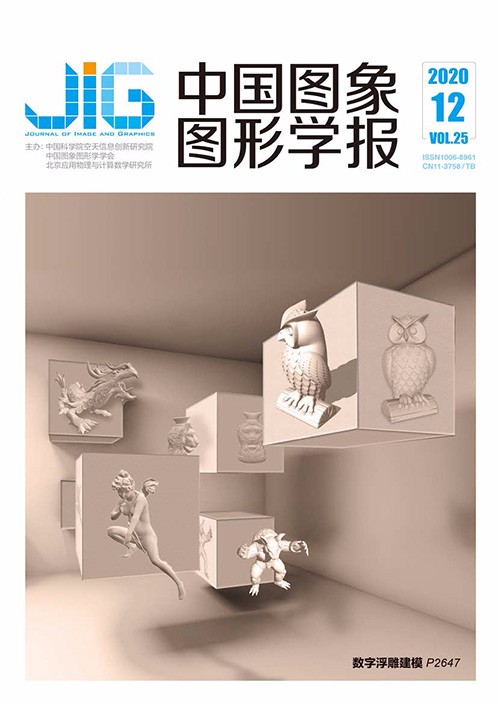
局部特定空间关系统计特征的RVIN噪声检测器
摘 要
目的 随机脉冲噪声(random-valued impulse noise,RVIN)检测器将局部图像统计值(local image statistics,LIS)作为图块中心像素点是否为噪声的判断依据,但LIS的描述能力较弱,在不同程度上制约了RVIN检测器的检测正确率,影响了后续开关型降噪模块的修复效果。为此,提出了一种基于局部特定空间关系统计特征的RVIN噪声检测器。方法 以局部中心像素点的8个邻域像素对数差值排序值(rank-ordered logarithmic difference,ROLD)并结合1个最小方向对数差值(minimum orientation logarithmic difference,MOLD)共9个反映局部特定空间关系的LIS统计值构成描述中心像素点是否为RVIN的噪声感知特征矢量,并通过在大量样本图块数据上提取的RVIN噪声感知特征矢量及其对应的噪声标签作为训练对(training pairs),训练获得一个基于多层感知网络(multi-layer perception,MLP)的RVIN噪声检测器。结果 对比实验从检测正确率和实际应用效果2个方面检验所提出的RVIN检测器的有效性,分别在10幅常用图像和50幅BSD (Berkeley segmentation data)纹理图像上进行测试,并与经典的脉冲噪声降噪算法中包含的噪声检测器以及MLPNNC (MLP neural network classifier)噪声检测器相比较,以漏检数、误检数和错检总数作为评价噪声检测正确率的指标。在常用图像集上本文所提RVIN检测器的漏检数和误检数较为平衡,在错检总数上排名处于所有对比算法中的前2名,为后续的降噪模块打下了很好的基础。在BSD纹理图像集上,将本文提出的RVIN检测器和GIRAF (generic iteratively reweighted annihilating filter)算法组合构成一种RVIN噪声降噪算法(proposed-GIRAF),proposed-GIRAF算法在50幅BSD图像上的峰值信噪比(peak signal-to-noise ratio,PSNR)均值在各个噪声比例下均取得了最优结果,与排名第2的对比算法相比,提升了0.471.96 dB。实验数据表明,所提出的RVIN噪声检测器的检测正确率优于现有的检测器,与修复算法联用后即可获得一种降噪效果更佳的开关型RVIN降噪算法。结论 本文提出的RVIN噪声检测器在各个噪声比例下具有鲁棒的预测准确性,配合GIRAF算法使用后,与经典的RVIN降噪算法相比,降噪效果最佳,具有很强的实用性。
关键词
Random-valued impulse noise detector using local spatial structure statistics
Yu Haiwen, Yi Xinwei, Xu Shaoping, Lin Zhenyu, Liu Ruirui(School of Information Engineering, Nanchang University, Nanchang 330031, China) Abstract
Objective Random-valued impulse noise (RVIN) is a common cause of image degradation that is frequently observed in images captured by digital camera sensors. In addition to degrading image quality, this type of noise also leads to pixel failure and inaccurate storage location or transmission. The presence of impulse noise may also introduce difficulties in feature extraction, target tracking, image classification, and subsequent image processing and analysis works. For RVIN, the noise value of a corrupted pixels uniformly distributed between 0 and 255. In this case, detecting the RVIN is very difficult. The available local image statistics for RVIN detection, which are used to determine whether the center pixel of an image patch is corrupted by RVIN noise or not, have are latively weak description ability, thereby restricting their accuracy to some extent and affecting the restoration performance of subsequent switching RVIN denoising modules. Method Nine local image statistics, including eight neighbor rank-ordered logarithmic difference (ROLD) statistics and one min-imum orientation logarithmic difference (MOLD) statistics, were used to construct a highly sensitive RVIN noise-aware feature vector that can describe the RVIN likeness of the center pixel of a given patch. Based on this vector, RVIN noise-aware feature vectors extracted from numerous noisy patches, their corresponding noise labels were formed as a set of training pairs for a multi-layer perception (MLP) network, and the MLP-based RVIN detector was trained. Result Comparative experiments were performed to test the estimation accuracy and denoising effect of the proposed RVIN detector. The proposed detector was compared with several state-of-the-art image denoising methods, including progressive switching median filter(PSMF), ROLD-edge preserving regularization(ROLD-EPR), adaptive switching median(ASWM), robust outlyingness ratio nonlocal means(ROR-NLM), MLP-edge preserving regularization(MLP-EPR), convolutional neural network based(CNN-based), blind convolutional neural network(BCNN), and MLP neural network classifier(MLPNNC), to demonstrate its estimation accuracy. Two image sets were used in the experiments. One image set included the "Lena", "House", "Peppers", "Couple", "Hill", "Barbara", "Boat", "Man", "Cameraman", and "Monarch" images, whereas the other set contained 50 textured images that were randomly selected from the BSD database(unlike the noise detection model training set). For a fair comparison, all competing algorithms were implemented in the MATLAB 2017b environment on the same hardware platform. To verify the estimation accuracy of the proposed RVIN detector, we applied different RVIN noise ratios to images taken from commonly used image sets, applied the proposed detector to count the instances of error, false, and missed detections for a noisy image, and compared its performance with that of existing classical RVIN noise reduction algorithms. Usually, a higher rate of error detection indicates that more noise has been left undetected in an image, and a false detection can reduce the noise of normal non-distorted pixels during the noise reduction stage, which can lead to blurry images. The total number of errors represents the number of missed and false detections, whereas a smaller number of these detections corresponds to a lower algorithm detection error rate and a better image quality after noise reduction. Experimental results show that the proposed algorithm has a relatively balanced number of missed and false detections and ranks second among all compared algorithms in this respect, thereby offering a solid foundation for the subsequent noise reduction module. In the second image set, we combined the proposed RVIN detector with the generic iteratively reweighted annihilating filter(GIRAF) algorithm to form a RVIN noise reduction algorithm. To verify the effectiveness of the proposed detector, we applied different ratios of RVIN noise (i.e., 10%, 20%, 30%, 40%, 50%, and 60%) to 50 textured images and recorded the average peak signal-to-noise ratio (PSNR) of these images under each noise ratio. Experimental results show that the images restored by the proposed-GIRAF algorithm achieve the optimal PSNR under each noise ratio and that this algorithm greatly outperforms the Xu, Chen-GIRAF, and MLPNNC-GIRAF algorithms. The proposed-GIRAF algorithm also outperforms the second-best algorithm by 0.47 dB to 1.96 dB in terms of the average PSNR of its 50 images, thereby suggesting that the actual detection results of the proposed noise detector are the most effective for the subsequent noise reduction module. Experimental results also show that the proposed RVIN detector outperforms most of the existing detectors in terms of detection accuracy. As such, a switching RVIN removal method with an improved denoising performance can be obtained by combining the proposed RVIN detector with any inpainting algorithm. Conclusion Extensive experiments show that the estimation accuracy of the proposed MLP-based noise detector is robust across a wide range of noise ratios. When combined with the GIRAF algorithm, this detector significantly outperforms the traditional RVIN denoising algorithm in terms of denoising effect.
Keywords
image denoising random-valued impulse noise (RVIN) local spatial structure eight neighbor rank-ordered logarithmic difference (EN-ROLD) minimum orientation logarithmic difference (MOLD) multi-layer perception (MLP) detection accuracy
|



 中国图象图形学报 │ 京ICP备05080539号-4 │ 本系统由
中国图象图形学报 │ 京ICP备05080539号-4 │ 本系统由